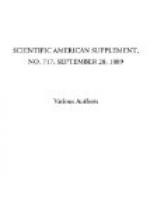[Illustration: FIG. 5.—THE SHIP AS SEEN FROM THE STAGE.]
The large mast consists of a vertical sheath 10 ft. high, which is set into the center of the frame, and in the interior of which slides a wooden spar that exceeds it by 5 ft. at first, and is capable of being drawn out as many more feet for the final apotheosis. This part of the mast carries three footboards and a platform for the reception of “supers.” It is actuated by a windlass placed upon the frame.
To form the skeleton of the vessel there are mounted upon the frame a series of eight large vertical trusses parallel with each other and cross-braced by small trusses. The upper part of these supports the flooring of the deck, and their exterior portion affects the curve of a ship’s sides. It is to these trusses that are attached the panels covered with painted canvas that represent the hull. These panels are nine in number on each side. Above are placed those that simulate the nettings and those that cover the prow or form its crest.
The turret that surrounds the large mast is formed of vertical trusses provided with panels of painted canvas and carrying a floor for the figurants to stand upon.
The bowsprit is in two parts, one sliding in the other. The front portion is at first pulled back, in order to hide the vessel entirely in the side scenes. It begins to make its appearance before the vessel itself gets under way. Light silken cordages connect the mast, the bowsprit, and the small mast at the stern.
On each side of the vessel, there are bolted to the frame that supports it five iron frames covered with canvas (Fig. 3), which reach the level of the water line, and upon which stand the “supers” representing the naiads that are supposed to draw the ship upon the beach. Finally at the bow there is fixed a frame which supports a danseuse representing the living prow of the vessel.
The vessel is drawn to the middle of the stage by a cable attached to its right side and passing around a windlass placed in the side scenes to the left (Fig. 2). It is at the same time pushed by machinists placed in the interior of the framework. The latter, as above stated, is entirely covered with painted canvas resembling water.
As the vessel, freighted with harmoniously grouped spirits, and with naiads, sea fairies, and graceful genii seeming to swim around it, sails in upon the stage, puts about, and advances as if carried along by the waves to the front of the stage, the effect is really beautiful, and does great credit to the machinists of the Opera.
We are indebted to Le Genie Civil and Le Monde Illustre for the description and engravings.
* * * * *
THE GIRARD HYDRAULIC RAILWAY.
[Illustration: FIG. 1.]
[Illustration: FIG. 2.]




